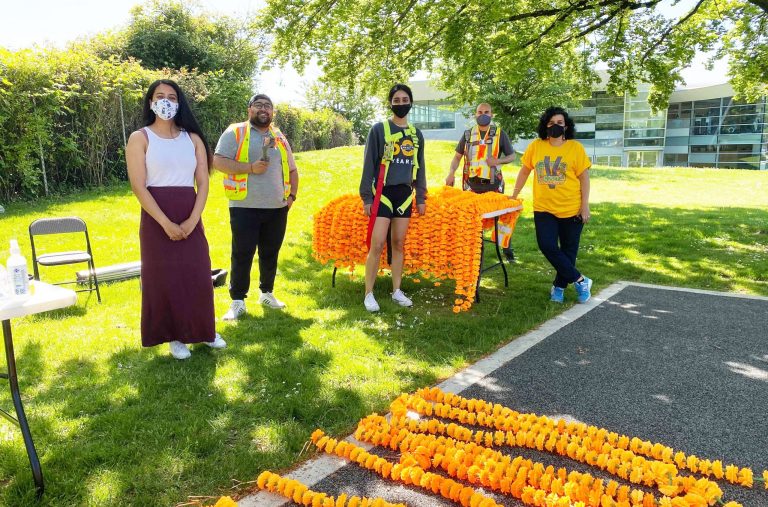Written by Roshni Riar, UBC Community Engagement.

Take your learning beyond the classroom and make a positive impact in a local community this summer. ACAM 390A: The Heritage of Chinese Migrations is a unique, community-focused learning experience that offers thoughtful opportunities to engage and build connections with communities throughout Vancouver and Asia.
“Students should consider taking ACAM 390 if they want a learning experience that breaks the boundaries of traditional education and takes a step further into helping local communities. ACAM 390 is a community-oriented course where your contributions can truly make a difference to the communities you work with.” — Donny Chiu (he/him/his), fourth year History student
Last summer, four ACAM 390A students partnered with the Punjabi Market Collective (PMC) to celebrate and highlight revitalization efforts happening at Vancouver’s Punjabi Market at Main and East 49th. Through that partnership, students created the following video essay, Punjabi Market: Resilient Cultures, Resilient Communities.
In advance of this year’s course, we connected with the students behind the project to learn about their experience working with local community organizers and why students should consider taking ACAM 390A.
 Bharat (he/him/his), fourth-year Geography student
Bharat (he/him/his), fourth-year Geography student
As a child, Bharat visited the Punjabi Market with his family but mostly shopped at Indian markets in Surrey. For him, this project was an opportunity to meet local business owners and appreciate the significance of the Punjabi Market to its community.
Considering ACAM 390 is titled “The Heritage of Chinese Migrations,” what drew you to the Punjabi Market for your final course project?
Our group was excited to focus on the Punjabi Market because it was the first time to be offered as an option in the course. Even though the Punjabi Market may differ from the other Asian heritage spaces highlighted in ACAM 390A, these sites often face similar issues such as gentrification. Since heritage sites do not often communicate with each other, our goal was to begin a conversation towards building a cross-cultural relationship between the Punjabi Market and other East Asian heritage spaces. By working together, we hoped to address shared struggles and create lasting relationships across the different communities.
How did your project support the needs of the community partner?
While planning our video, we worked closely with Jag Nagra, Creative Director, and Gulzar Nanda, President, to include the central initiatives of the Punjabi Market Collective. They explained the needs of the Punjabi Market, highlighting several community initiatives — including the Marigolds in the Market installation and Murals in the Market, done in conjunction with the Vancouver Mural Fest. We wanted to spread awareness about the Punjabi Market’s community initiatives, highlight the stories of its inhabitants, and communicate the importance of this space to its community.
Apply for ACAM 390A this summer
(July 4 to August 19, 2022).

Esther (she/her/hers), recent International Relations graduate
Before enrolling in ACAM390, Esther had never heard of Vancouver’s Punjabi Market. This project allowed Esther to explore a new heritage site and learn about the community that inhabits and keeps the market so lively and personal.
How did you include community voices in your project?
Our video features interviews with Jag Nagra and Gulzar Nanda, who had previously given a lecture about the Punjabi Market in our class. With the permission and guidance of Jag, Gulzar, and community members, our video features scenes of the streets, stores, and outdoor sights around the Punjabi Market. Additionally, Gulzar and Jag shared archival photos of the Punjabi Market which we used to support our story.
“By working with the Punjabi Market Collective, our research proved that there is a plethora of concrete and impactful ways that individuals can connect to thrive in the face of discrimination and racism, and it is this optimism that drives communities to embark on projects to preserve their community spirit.” — Esther Ong
What was your greatest takeaway while working with community partners in the Punjabi Market?
It is easy to be overwhelmed by the waves of online anti-inclusive messages, especially when coupled with everyday microaggressions. Yet, by working with the Punjabi Market Collective, our research proved that there is a plethora of concrete and impactful ways that individuals can connect to thrive in the face of discrimination and racism. It is this optimism that drives communities to embark on projects to preserve their community spirit.
I loved the Punjabi Market’s innovative collaboration with Murals in the Market, which created a space for local artists to showcase their work. It proved to me that the stereotype of grassroots efforts being ‘small-scale’ is anything but that.
Get involved with the Punjabi Market Collective.
 Ky (he/him/his), fourth year Media Studies student
Ky (he/him/his), fourth year Media Studies student
Like Esther, this project was Ky‘s first encounter with the Punjabi Market. The project allowed him to understand the importance of building culturally diverse community spaces. He particularly enjoyed speaking with the community members.
Why should students want to get involved in heritage sites like the Punjabi Market?
Being involved in heritage sites and regenerative efforts allows you to recognize how place-making initiatives play a fundamental role in influencing social inclusion. You realize how much an individual’s dedication matters in community engagement. It was so rewarding to directly experience another culture and contribute to the livability of communities like the Punjabi Market in Vancouver.
How involved was the PMRC in your project? And how did you share the final video with the community?
The PMRC was involved in every process of our project. Gulzar and Jag shared their personal stories and helped us film inside the Himalaya Restaurant and Hi-Class Jewelers, two businesses in the Punjabi Market. After ACAM 390A’s Virtual Community Showcase, we shared our final project video on the PMRC’s social media channels, with the Indian Summer Festival, and on UBC INSTRCC’s social media channels.
Check out Himalaya, HC Jewellers, Murals in the Market, and Dank Mart the next time you visit Punjabi Market on Main Street & 49th.
 Donny (he/him/his), fourth year History student
Donny (he/him/his), fourth year History student
Prior to the course, Donny wasn’t aware of the Punjabi Market or its revitalization efforts. For Donny, this project was an opportunity to connect with an important Punjabi heritage community and meet new people from diverse communities.
How did community engaged learning add to your UBC experience?
This project was the culmination of everything we had learned in ACAM 390A. It gave my groupmates and I the opportunity to both interpret and synthesize the lessons we learned with our personal experiences to create our video essay — with input from the Punjabi Market Collective.
Likewise, community-engaged learning humanized my lessons in a way I had never experienced before by adding a layer of interaction with the community that we had been learning about.
Why should other students consider taking ACAM 390A?
Other students should consider taking ACAM 390 if they want a learning experience that breaks the boundaries of traditional education and takes a step further into helping local communities. ACAM 390 is a community-oriented course where your contributions can truly make a difference to the communities you work with. As a bonus, ACAM 390A is taught by one of the wittiest and most amiable professors I have ever known (Dr. Henry Yu)!

Members of the Punjabi Market Collective preparing for the Marigolds in the Market installation.
Jag Nagra, Creative Director of the Punjabi Market Collective, spoke to the benefits of partnering with students, while highlighting their eagerness to share the market’s history and their revitalization work.
“What I was most impressed with was the fact that they listened to the feedback we provided. They made adjustments to ensure the final product aligned with our goals and the sensitivities to the work we do,” said Jag. “I couldn’t be happier with the result.”
Jag found it refreshing to bring student perspectives to Punjabi Market advocacy. For a long time, this responsibility fell primarily on business owners in the market.
ACAM 390A is a unique course, and if you’re seeking a community-engaged style of learning, it just might be the one for you. Over the span of a few summer months, you can explore new communities, learn from local organizations and heritage initiatives, and make important connections along the way.
 Faculty of Art
Faculty of Art